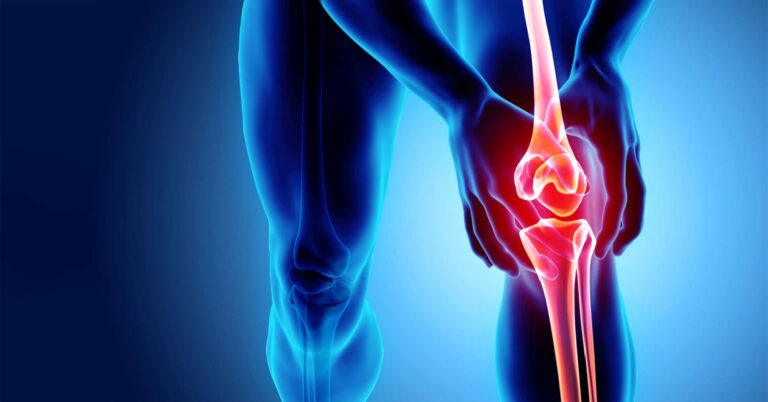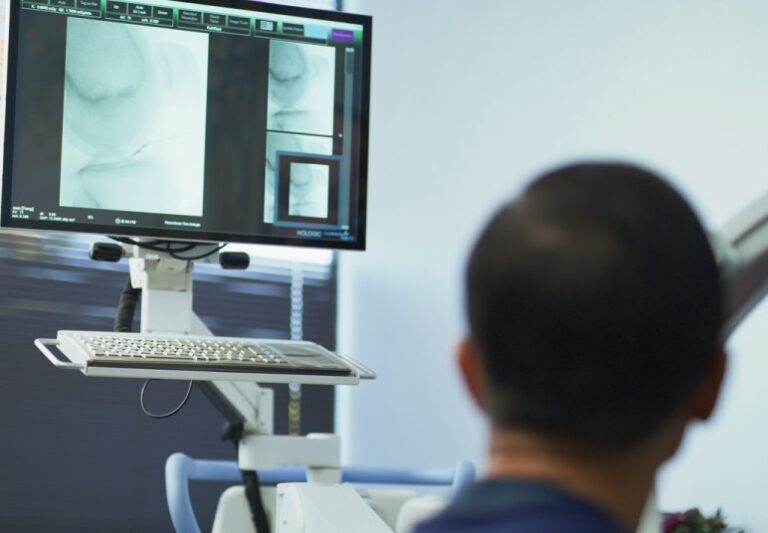Osteoarthritis
When you’re grappling with painful knees from Osteoarthritis, finding relief becomes a top priority. While Osteoarthritis itself isn’t curable, various treatment options exist to alleviate symptoms. Knee replacement surgery is often recommended by orthopedic doctors as a viable solution. However, before you rush to schedule your surgery, it’s crucial to understand the cost of knee replacement surgery—not just financially, but also in terms of time and its impact on your overall quality of life—and what are the non-surgical options for knee pain? Financial Cost of Knee Replacement Surgery The financial aspect of knee replacement surgery can vary significantly based on several factors: Time Cost of Knee Replacement Surgery Time is one of your most precious resources, so it’s important to understand the potential time-cost of knee replacement surgery as well. When evaluating the cost of knee replacement surgery, consider the duration of the procedure itself, the recovery period, and the impact on daily life and work commitments. Cost of Knee Replacement Vs Gel Knee Injections (Viscosupplementation) At the Joint Relief Institute, we understand that for some, knee replacement surgery may be the best option for advanced osteoarthritis. However, we encourage patients to explore less invasive treatments first. Our FDA-approved knee gel injections offer a quick, non-invasive solution with no downtime. With a 90% success rate among over 30,000 patients, our exclusive treatment method has helped many avoid surgery altogether. If you’re looking for alternatives to surgery to relieve your knee pain, please contact us today to learn more about your options.
Read MoreAre you considering viscosupplementation injections for knee osteoarthritis? Let’s delve deeper into this treatment option. Viscosupplementation, also known as gel therapy, involves injecting hyaluronic acid into the knee joint. But what exactly does this procedure entail, and how does it work to alleviate osteoarthritis symptoms? Knee osteoarthritis is a condition characterized by the breakdown of cartilage in the knee joint, leading to pain, stiffness, and reduced mobility. One of the contributing factors to these symptoms is the depletion of hyaluronic acid, which normally provides lubrication and cushioning within the joint. Viscosupplementation injections aim to replenish this diminished hyaluronic acid by introducing hyaluronic acid into the knee joint. Hyaluronic acid is a natural substance found in the body, particularly in the synovial fluid and connective tissues. It has a viscous, gel-like consistency, which helps lubricate and cushion the joint surfaces, reducing friction and allowing for smoother movement. By injecting hyaluronic acid directly into the knee joint, viscosupplementation injections work to: While the effectiveness of viscosupplementation injections may vary from person to person, many individuals experience significant relief from pain and improved function following treatment. If you would like to learn more about viscosupplementation at the Joint Relief Institute, please call 1-800-238-9307 for a no obligation consultation.
Read MoreIntroduction Receiving a diagnosis of knee osteoarthritis can be overwhelming and potentially life-altering. However, it’s essential to remember that you’re not alone, and there are steps you can take to manage this condition and improve your quality of life. In this blog post, we’ll discuss the three most important things to do after you receive a knee osteoarthritis diagnosis. Educate Yourself About Osteoarthritis Understanding your condition is the first crucial step in managing knee osteoarthritis effectively. Start by learning the basics: a. What is Osteoarthritis? Osteoarthritis (OA) is a degenerative joint disease that primarily affects the cartilage, the protective tissue that covers the ends of your bones. When cartilage deteriorates, it can lead to pain, stiffness, and decreased joint function. b. Causes and Risk Factors: Familiarize yourself with the factors that can contribute to the development of knee OA, such as age, genetics, obesity, joint injuries, and joint misalignment. Knowing these risk factors can help you make informed lifestyle choices. c. Symptoms: Recognize the common symptoms of knee OA, which include pain, swelling, stiffness, decreased range of motion, and a grating sensation when moving the knee joint. Seek Professional Guidance After receiving a knee osteoarthritis diagnosis, it’s essential to collaborate with healthcare professionals who specialize in managing this condition. In addition to a primary care physician, the Joint Relief Institute has extraordinary providers, technicians, and specialists who will effectively treat your osteoarthritis while communicating with you every step of the way. Our process, known as viscosupplementation, is a pain-free gel injection that has been shown to provide instant and long-lasting relief for patients with osteoarthritis of the knee. Though treatment varies for each individual person, our in-house providers will be able to develop a treatment strategy tailor-made for your joints. Moreover, our fluoroscopy machines allow for highly accurate injections and effective placement of the fluids – even highly experienced physicians who do not use fluoroscopy cannot ensure an accurate gel injection. We’ve seen incredible results in countless patients, and we’d love to help you as well. Develop a Self-Care Plan Knee osteoarthritis management extends beyond medical treatments. To enhance your overall well-being, consider the following self-care strategies: a. Exercise Regularly: Engage in low-impact exercises such as swimming, cycling, or walking to maintain joint mobility and strengthen the surrounding muscles. Always consult with your physical therapist or healthcare provider before starting any new exercise routine. b. Maintain a Healthy Diet: Focus on a balanced diet rich in anti-inflammatory foods like fruits, vegetables, and omega-3 fatty acids. These choices can help reduce inflammation and support joint health. c. Manage Stress: Chronic pain can lead to emotional distress. Explore stress-reduction techniques such as meditation, deep breathing, or mindfulness to improve your mental and emotional well-being. d. Monitor Your Symptoms: Keep a journal to track your pain levels, activities, and any changes in symptoms. This record can help you and your healthcare provider adjust your treatment plan as needed. During your treatment at the Joint Relief Institute, our providers will be able to collaborate with you on a holistic plan that encompasses these four bullet points. We recognize that every patient is different, and we’re willing to develop health plans that work for every individual. Conclusion A knee osteoarthritis diagnosis doesn’t have to be a life sentence of pain and limited mobility. By educating yourself, seeking professional guidance, and developing a self-care plan, you can effectively manage your condition and improve your quality of life. The Joint Relief Institute will also always be a phone call away to help you with treatment and recovery. Though an osteoarthritis diagnosis is daunting and challenging, with the right steps, you can find relief and regain your mobility.
Read MoreThe Joint Relief Institute is able to bring relief and hope to new patients every day, and we owe our ability to treat these patients to our incredible providers. Not only are our providers dedicated, talented, diligent, and communicative, but they believe in our mission and enjoy coming to work every day. We were lucky enough to be able to interview some of these fantastic providers, doctors, and technicians about their favorite parts of coming into JRI and are now sharing their answers with you! We asked four JRI staff members about their favorite parts of coming into the Joint Relief Institute… “My favorite part about coming into JRI would be the atmosphere. It doesn’t feel much like a job but more like a family. And I would say that’s because of the employees but also because of the patients. They’re all like family to us. We see them for 5 weeks in a row every 6 months and you start to build a relationship with them.” “My favorite part about coming into JRI is the relationships I have created with the patients who have been coming here for the past six and a half years.” “My favorite part about coming into work at JRI is not only be a part of an establishment that helps our patients receive relief and genuine care but the staff I work with makes a huge difference.” “I love the relationships I have built over the past 4 years – with staff and with our patients. So many stories and memories.” If you are suffering from osteoarthritic joint pain, or know someone living with osteoarthritis, book an appointment with the Joint Relief Institute by calling us at (708)-726-3112! Our providers can’t wait to build a special relationship with you just like we have with countless other patients.
Read MoreIntroduction: As the days grow shorter and the temperature drops, many of us find ourselves facing the challenges that come with cooler weather. If you’re one of the millions of people dealing with osteoarthritis, you may be all too familiar with how the changing seasons can affect your joint health. The Joint Relief Institute sees and helps countless patients who struggle in the autumn and winter seasons – and we’d like to be able to share our advice to as many osteoarthritic folks as possible. In this article, we’ll explore some effective strategies to help you stay comfortable and active during the colder months. Stay Active, Indoors: The colder weather may discourage outdoor activities, but that doesn’t mean you have to stay sedentary. Regular exercise is essential for managing osteoarthritis. Consider indoor activities like yoga, tai chi, or swimming at a heated pool. These low-impact exercises can help improve joint flexibility and reduce pain. Don’t forget to stretch before and after your workouts to keep your muscles and joints limber. Heat and Cold Therapy: Hot and cold therapy can provide immediate relief for sore joints. Apply a warm compress over your muscles (heat can cause inflammation for joints) or take a warm bath at home to ease stiffness and reduce pain. On the other hand, cold packs can help reduce inflammation over your joints and numb the area. Remember to use these therapies in moderation, and always follow the recommended time guidelines. Supportive Footwear: Investing in proper footwear is crucial for joint relief, especially if you have osteoarthritis in your lower body. Look for shoes that offer good arch support and cushioning to reduce stress on your joints. Orthotic insoles can also provide additional support and help alleviate discomfort. Providers at the Joint Relief Institute will be able to offer recommendations as well! Physical Therapy: Physical therapy can be highly beneficial in managing osteoarthritis. A trained therapist can provide exercises and techniques tailored to your specific needs, helping you build strength and flexibility while minimizing pain. Stay Warm: As the weather cools down, it’s essential to keep your joints warm. Layer your clothing, wear gloves, and use heating pads or electric blankets when needed to maintain a comfortable body temperature and reduce joint stiffness. Conclusion: Managing osteoarthritis during the cooler months is entirely possible with the right strategies. By staying active, maintaining a healthy lifestyle, and implementing targeted therapies like heat and cold treatments, you can find relief and improve your quality of life. Remember, you may always reach out to the providers at the Joint Relief Institute for a personalized plan that best suits your unique needs and goals. Stay warm, stay active, and stay on track for healthy joints this season.
Read MoreAt the Joint Relief Institute, our number one concern is making sure that ourpatients are able to manage symptoms of osteoarthritis and maintain a fulfilling andactive life, even after they are finished with our gel injections. Living withosteoarthritis can be challenging, but making conscious dietary choices can have asignificant impact on managing the condition. While there’s no one-size-fits-allapproach, certain foods can exacerbate inflammation and discomfort in arthriticpatients. In this article, we’ll delve into some crucial insights from a US News reporton foods to avoid for patients with arthritis, helping you make informed choices toalleviate symptoms and improve your overall quality of life. Sugar and Processed Foods High consumption of sugar and processed foods has been linked to increasedinflammation. These foods often contain unhealthy fats, additives, andpreservatives that may trigger joint discomfort. Opt for whole, unprocessed foodswhenever possible to reduce inflammation levels. As the US News report suggests,“Choose fresh fruits, vegetables, lean proteins, and whole grains.” Red and Processed Meat Red and processed meats are rich in saturated fats that can contribute toinflammation. These fats may trigger the release of certain inflammatory chemicalsin the body. US News advises, “Limit red meat and processed meats and opt forleaner protein sources such as fish, poultry, beans, and lentils.” Refined Carbohydrates Refined carbohydrates, found in white bread, pasta, and sugary snacks, can causespikes in blood sugar levels and promote inflammation. Instead, choose wholegrains like brown rice, quinoa, and whole wheat to help maintain stable blood sugarlevels and reduce inflammation, as recommended by the US News report. Dairy Products Some individuals with osteoarthritis find that dairy products, particularly full-fatdairy, can exacerbate joint pain. This might be due to the saturated fats andproteins in dairy. The US News report suggests, “Experiment with plant-based milkalternatives and lean sources of calcium.” Fried and Processed Foods Fried and processed foods are often high in unhealthy fats, trans fats, and additivesthat can contribute to inflammation and overall health problems. The US Newsreport recommends, “Cut back on fried foods and opt for cooking methods likebaking, grilling, or steaming.” As you navigate your journey with osteoarthritis, it’s essential to pay attention toyour diet and its impact on your symptoms. In addition to this article, our providerswill be able to offer you valuable insights into dietary habits that are beneficial forarthritic patients. By avoiding or minimizing the consumption of sugar, processedfoods, red meat, refined carbohydrates, and certain dairy products, you can takeproactive steps toward managing your osteoarthritis and improving your overallwell-being.
Read MoreAbout Dr. Hana
Mike Hana is triple board certified in Anesthesiology, Pain Medicine and Interventional Pain Practice. He completed his fellowship at the University of Texas, where he also served as an assistant professor training and teaching other physicians the science and the art of performing Image-guided interventions for pain management.





